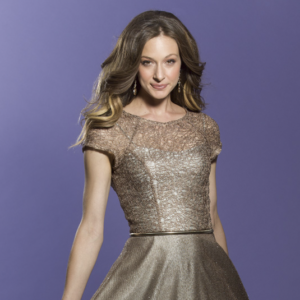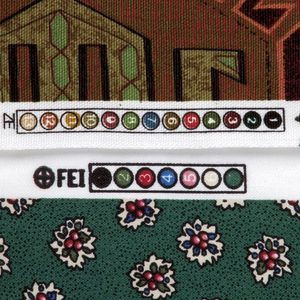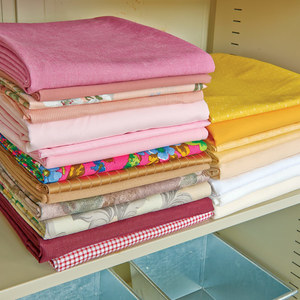Walk into the home decorating section of a fabric store and you may be confronted with some fabric names and terms that are not familiar. Here’s a handy guide to help you get started.
Canvas
Cotton, cotton/poly blend. This is a very stiff cloth, similar to drill and sailcloth, but lighter. It is a very durable cloth. Use it for tote bags, upholstery, lightweight jackets, and coats. It’s easy to sew, but requires some patience because it can be stiff.
Chenille
Cotton, rayon, blends. In home dec, chenille is a fuzzy patterned fabric usually seen in upholstery and bedspreads. Chenille can be used for upholstery, accent pillows, bedspreads, handbags, and throws. It’s easy to sew, but you may need to clean your workspace frequently. It has a tendency to shed in the wash. Machine wash.
Chintz
Cotton, cotton-poly blends. Chintz is notable for its shiny, glazed face and flat back side. Chintz is usually printed with a floral design, and can be used for upholstery, draperies, tablecloths, and accent pillows. Machine wash or dry clean, though machine washing may remove glazing.
Corduroy
Cotton, cotton blends. A rugged cloth woven with a nap that is cut into vertical ribs, or “wales.” Originally worn by servants of the French monarchy (“Corps du Roi,” hence the name), this very durable cloth can be plain, or, nowadays, embellished with printing or embroidery. Corduroy can be used in upholstery, accent pillows, and handbags. It’s easy to sew. Machine wash and dry.
Curtain sheer
Nylon, cotton, polyester, rayon, blends. This fabric is used for sheer curtains and drapes. It comes in different types, ranging from a very slippery nylon sheer to a plain-weave voile. The nylon sheer can be very difficult to work with. Machine wash and hang to dry, or dry clean.
Damask
Wool, cotton, linen, silk, polyester, blends. Damask is a frequently reversible fabric that is woven on jacquard looms. It is flatter and more durable than its cousin, brocade. Usually woven in a solid color, damask is one of the oldest fabrics. Depending on the weight, damask can be used for table linens, curtains, or upholstery. Care depends on fabrication. Poly, cotton, and others can be machine washed, while other fibers must be dry cleaned or spot cleaned.
Denim
Cotton, cotton blends. Denim is a rugged twill cloth that gets its name from Nimes, France, the town where it was first made. The French originally called the cloth Serge de Nimes. This easy-to-sew fabric is used for slipcovers, upholstery, and curtains. Machine wash.
Dupioni
Silk, polyester, blends. Dupioni is a lustrous light- to medium-weight fabric made from a tight plain weave that has slubbed yarns on the cross-weave or weft. These slubs, or irregular threads, give dupioni its characteristic texture. For home dec, dupioni fabric is often embroidered or sewn into patterns. Use it for curtains, accent pillows, tablecloths, bedspreads, and duvets. Dupioni is easy to average to sew, and fades easily in strong sunlight. Machine wash or dry clean.
Duck cloth
Heavy canvas, usually made of cotton or blends. Use duck cloth for director’s chairs, upholstery, and tote bags. Duck cloth is moderately difficult to sew. Machine wash.
Fake fur
Polyester, nylon, acrylic. This is usually a knitted fabric with long pile on one side designed to look like fur. Use it for accent pieces like throws and pillows. Fake fur has an average difficulty to sew. Dry clean.
Gauze
Cotton, wool, silk, poly/blends. Gauze is an easy-to-sew sheer, open-weave fabric that is used for curtains. Cotton and blends are machine washable, while other fibers are dry clean only.
Lace
Cotton, rayon, nylon, polyester, silk. Lace comes in varying widths from 12 inches to 84 inches wide, and often has eyelets on one selvage of the fabric for curtain rods. Use lace for curtains and tablecloths. In most cases, it’s easy to sew. Machine wash or dry clean, depending on the fabrication.
Linen
A sturdy fabric made from the flax plant. Linen comes in plain or damask weaves, and is available in weights from handkerchief linen to very heavyweight. It’s used for curtains, slip covers, and upholstery. Linen wrinkles easily unless it’s pre-treated, but it’s easy to sew. Machine wash or dry clean.
Muslin
Cotton, cotton blends. Muslin is an inexpensive, plain-weave fabric. Use muslin for curtains and curtain linings. Machine wash. Make sure you pre-treat, though, because it tends to shrink quite a bit.
Osnaburg cloth
Cotton, blends. Osnaburg cloth is “the mother of all home-dec fabrics.” It is a plain-weave fabric that manufacturers use as the base for printed fabrics. It is also the base fabric for chintz. Use it for draperies, curtains, and upholstery. Osnaburg cloth is easy to sew. It has a tendency to shrink significantly, especially inexpensive versions, so pretreat before sewing. Machine wash or dry clean.
Raw silk
Silk. This rough-weave fabric contains the slubs and waste fibers from fine silk weaving. It comes in a number of weights, from lightweight silk noil to very heavyweight silk tussah. Many of the looser weaves ravel easily. Price per yard can range from a few dollars to very expensive. Use it for upholstery, curtains, and pillows. It is easy to average difficulty to sew. Many dyed raw silks have a tendency to bleed their dyes, and many raw silks shred when washed. To prevent this, wash dark colors separately and finish raw edges. Dry cleaning is recommended.
Taffeta
Silk, polyester, rayon, nylon, acetate, blends. This smooth, plain-weave fabric has a firm hand and characteristic rustle. Use it for draperies, curtains, and upholstery. Polyester and manmade taffetas tend to be inexpensive. Some silk taffetas can be very dear. Taffeta is moderately easy to sew. Dry clean or hand wash.
Toile
Cotton, cotton/poly blend. The name toile is sometimes used interchangeably with chintz. The fabric can be glazed or not. Toile is often printed with French pastoral scenes. Use this easy-to-sew fabric for draperies, curtains, duvet covers, pillows, and tablecloths. Machine wash.
Velvet
Usually cotton/polyester blend. This luxurious fabric has a short pile on a woven background. Use it for draperies, upholstery, slipcovers, and throws. Velvet is easy to moderately difficult to sew. Dry clean.



































Log in or create an account to post a comment.
Sign up Log in